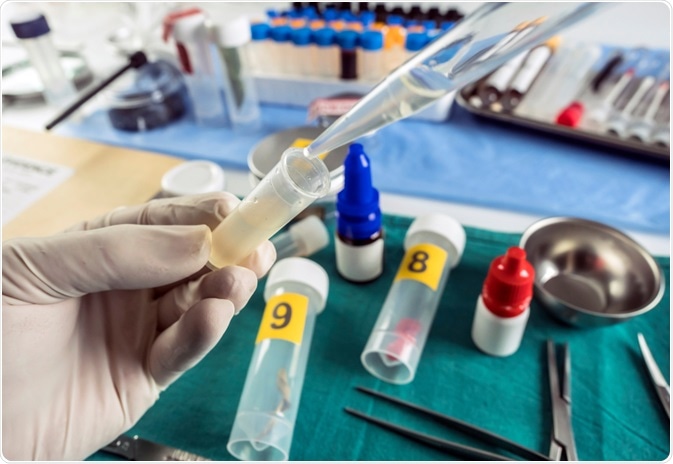DNA profiling provides significant information about the victim or perpetrator associated with a particular crime scene. However, identifying the context of the crime may be difficult as DNA does not give which part of the body that the biological material recovered originated from. This problem means there is no evidence to indicate which crime was committed and what charges should be assessed to the crime.

Image Credit: felipe caparros/Shutterstock.com
To solve this predicament, a technique of cell-specific mRNA expression has been used to identify the specific body fluids from the biological materials recovered. The abundance and the presence of the type of mRNA can reveal the gene expression pattern that is specific to each cell type and body fluid across the body.
Advantages of using RNA-based Methods
RNA based methods, such as mRNA profiling has been studied to have numerous advantages compared to past methods of using DNA in forensic analysis. The mRNA profiling method is known for its higher specificity in detecting cell types and body fluids, the capability to co-extract both DNA and RNA, and its ability to detect multiple body fluids and markers by a common assay format.
Another advantage of using RNA as a method for forensic identification is the ability of the microRNA-based body fluid identification assay to provide high specificity due to its difference in the microRNA expression profile in every part of the body fluid.
Whereas past conventional methods may present limitations such as the timeliness, labor cost, and sample consumption due to the requirement to perform the analysis in series.
MicroRNA method specific to body fluids relevant to forensic casework
The method has been proven to be specific to body fluids that are relevant in forensic casework, such as menstrual blood, vaginal secretions, semen, and saliva. These body fluids are differentiated based on the presence or absence of the microRNA in these biological materials.
These body fluids are further differentiated by the abundance of these microRNA that are present within those body fluids. In addition, the cells in the microbiome are even more abundant than human cells, which serves as an advantage in forensic analysis due to the trace amount of the sample present at crime scenes.
Nevertheless, the microRNA usage as a forensic identification method is still under development and the method also requires additional statistical analysis to interpret results accurately.
A fluorescently labeled antibody can distinguish between genital cells to oral body cavity cells
A common difficulty often faced in differentiating between two cells from a human body exist within buccal and vaginal epithelial cells, due to their similarities in morphology. Fleming et al. suggested that potential specific mRNA transcripts, as well as bacterial species, may provide identification of vaginal cells.
A study done by Fleming et al. uses the mouse monoclonal anti-estrogen receptor-1 antibody to examine the vaginal and buccal cells through the Leitz Diaplan microscope attached to an epifluorescence.
Through the digital images taken by a reflex camera, they found that there is a difference in the fluorescence level between the two biological samples. The vaginal cells have a higher level of fluorescence compared to the fluorescence level corresponding to the buccal cells.
Identification of skin and relevant body fluids in forensics by Targeted RNA sequencing
Another method of how body fluids can be identified by RNA-based methods is through the development of a multiplexed biomarker panel that has gene amplicons in equal sizes. The biomarker panel developed is comprised of several gene targets that are highly specific, that they can identify biological fluids such as saliva, vaginal secretions, semen, blood, menstrual blood, semen, as well as skin tissues.
Through this method, Hanson, et al. was able to identify even the minor component bodily fluid having moderate or low expressing biomarkers, saliva. The method can also detect two fluid types in complex mixtures, which is beneficial especially when analyzing forensic samples that are usually found in mixtures comprising of different chemical components.
Nevertheless, the method does not provide the association of the component bodily fluid to the DNA profile associated with it, information that will be more beneficial and providing probative value to the forensic investigation.
Cross-reactivity and stability of RNA pose limitations as a forensic identification method
Overall, using mRNA markers can provide higher specificity than DNA to identify the associated body fluid, yet cross-reactivity within body fluids still exists as a limitation. This limitation in the discriminatory power can be improved by including all of the body fluids' mRNA markers.
Moreover, degradation becomes a problem when working with mRNA and its instability may present issues for forensic identification. Although that microRNA can be used as a substitute for large mRNAs due to their small size being less susceptible to degradation, method validation is still needed due to an issue of its reproducibility.
References
- Fleming, R., Harbison, S., and Lin, M.H. (2013). ‘New RNA methods for the identification of body fluids and cell types.’ Forensic Science International: Genetics Supplement Series, 4(1), pp.e87-e88. https://scholar.google.com/scholar?hl=en&as_sdt=0%2C10&q=New+RNA+methods+for+the+identification+of+body+fluids+and+cell+types&btnG=#
- Hanson, E., Ingold, S., Haas, C., and Ballantyne, J. (2018). ‘Messenger RNA biomarker signatures for forensic body fluid identification revealed by targeted RNA sequencing.’ Forensic Science International: Genetics, 34, pp.206-221. https://www.biorxiv.org/content/10.1101/247312v1.full.pdf
- Haas, C., Klesser, B., Maake, C., Bär, W. and Kratzer, A. (2009). ‘mRNA profiling for body fluid identification by reverse transcription endpoint PCR and realtime PCR.’ Forensic Science International: Genetics, 3(2), pp.80-88.
- Wang, Z., Zhang, S.H., Di, Z., Zhao, S.M., and Li, C.T. (2013). ‘Messenger RNA profiling for forensic body fluid identification: research and applications.’ Fa yi xue za zhi, 29(5), p.368. https://pubmed.ncbi.nlm.nih.gov/24466779/
- Hanson, E.K., Lubenow, H., and Ballantyne, J., 2009. Identification of forensically relevant body fluids using a panel of differentially expressed microRNAs. Analytical Biochemistry, 387(2), pp.303-314. https://www.sciencedirect.com/science/article/pii/S0003269709000657?via%3Dihub
Further Reading
Last Updated: Aug 30, 2022